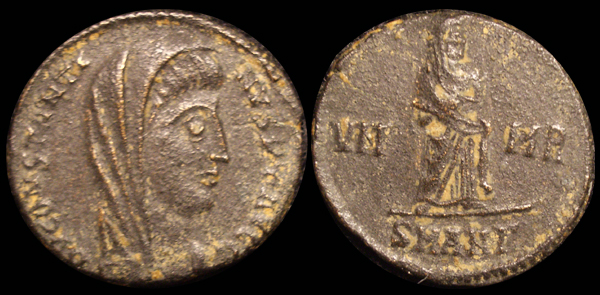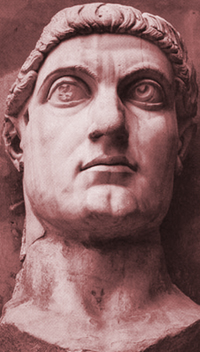
AE Follis - IMP CONSTANTINE I (Commemorative AD 347/348)
(RIC VIII 112)
- Antioch Mint
Marcus Flavius Valerius Constantius
Born: 271 (est)
Emperor: A.D. 306-337
Obverse: Portrait veiled bust right - DV CONSTANTINVS PT AVGG
Reverse: Constantine togate and veiled standing facing right - VN-MR to left and right SMAN(GAMMA)
|
Inscriptions: D(i)V(us) CONSTANTINVS PT (Pater) AVGG(ustus) (Double G on Augustus means two emperors Constantine II and Constantius II with Constans under guardianship of the former) / VN (Venerabilis) MR (Memoria) SMAN(Gamma) (Antioch Mint) Divus Constantine Father Augustus / Revered Memory - Minted in Antioch Constantine I or Constantine the Great was born in Moesia the son of the emperor Constantius (Constanius I Chlorus). He served with distinction under Diocletian and Galerius in the East serving directly under his fathers co Augustus Galerius for a time as as a token of good faith. He was allowed to go with his father Constantius to Britain to fight the Picts only to see his father die there and be proclaimed Augustus by his troops on July 25, 306. After a protracted and complicated attempt at power sharing and the strife and in fighting this often caused, Constantine Rose to become the sole ruler in the west after the defeat of Maxentius at the Battle of the Milvan Bridge. It is said that before his victory at the Battle of the Milvan Bridge where he defeated Maxentius and took sole power he had a vision that told him to use the cross as his standard. He attributed his subsequent victory to the Christian God and is said to have become a devout Christian and worked to unify that religion. Constantine is best remembered in modern times for the Edict of Milan in 313, which fully legalized Christianity in the Empire for the first time, and the Council of Nicaea in 325. these actions are considered major factors in the spread of the Christian religion. He is credited as being the first Christian Emperor by most through history and although there has been debate over how genuine his faith was because of his death bed baptism, it cannot be denied that he was a professed Christian till the day he died and took a very active role in the affairs of the church. Constantine busied himself with church affairs, grand building projects, and fighting his rival in the East, the emperor Licinius, whom he eventually defeated and killed making himself the sole ruler of the Roman Empire. Soon after, for reasons largely unknown, he killed his son Crispus and his other three sons mother, Fausta. Once he became the sole ruler of Rome Constantine's rule began in earnest. He renamed Byzantium and built a new city there called Constantinople. It resembled Rome and it would become the new capital of the Roman Empire. His building projects were immense, he rebuilt or refurbished other cities and he built grand churches like the Hagia Sophia. In government he was conservative. He made small reforms but was never a sweeping reformer in his affairs of State. He initiated monetary reform and revised the legal system and often gave the church power in governmental affairs. He continued as all before him to defend the borders of the empire against various threats from the Germans, Goths and Samartians. Constantine I died at Nicomedia on May 22nd 337 leaving three sons Constantine II, Constantius II, and Constans as successors. After a bloody palace massacre to purge possible rivals they took power and would eventually fight each other for the empire. |


